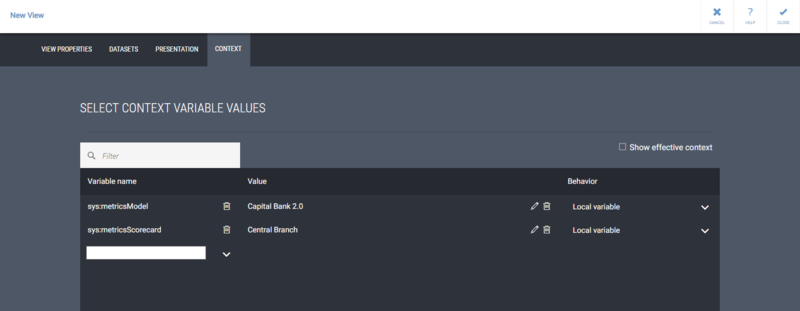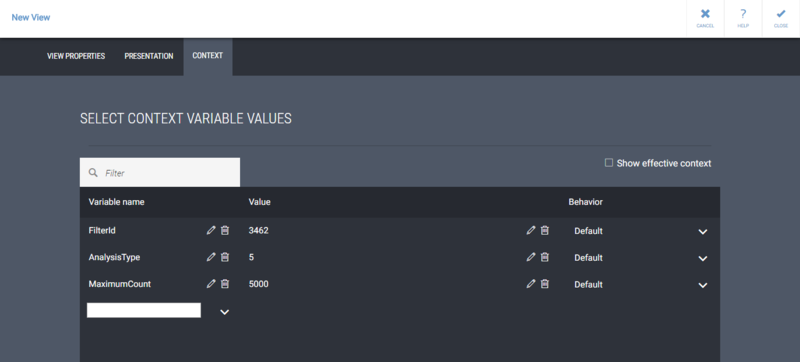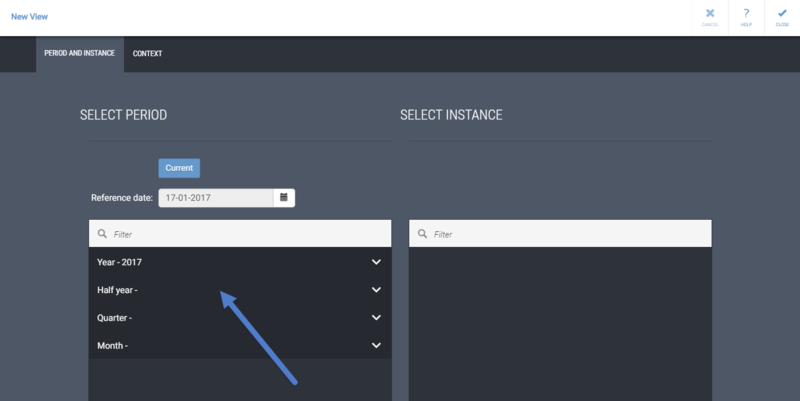Difference between revisions of "Template:MDBTutorialViewPropertiesAndContext"
Jump to navigation
Jump to search
(306933) |
|||
| Line 2: | Line 2: | ||
# Creating a new QPR MobileDashboard view starts by defining the Name, Description, and View [[Context]]. These are defined in the view properties that is opened by clicking the '''Properties''' button:<br>[[File:OpenViewProperties.png|800px]] | # Creating a new QPR MobileDashboard view starts by defining the Name, Description, and View [[Context]]. These are defined in the view properties that is opened by clicking the '''Properties''' button:<br>[[File:OpenViewProperties.png|800px]] | ||
# First, give your view a '''Name''' and a '''Description'''. Then, click '''Context''':<br>[[File:ViewProperties.png|800px]] | # First, give your view a '''Name''' and a '''Description'''. Then, click '''Context''':<br>[[File:ViewProperties.png|800px]] | ||
| − | # The context defines the starting points for later querying data from QPR EnterpriseArchitect/ProcessDesigner, QPR Metrics, and/or QPR ProcessAnalyzer. Define the context by selecting values for the context variables by first selecting a variable from the drop-down menu and then tapping the edit icon on the Value column:<br>[[File:ViewContext.png|800px]]<br> | + | # The context defines the starting points for later querying data from QPR EnterpriseArchitect/ProcessDesigner, QPR Metrics, and/or QPR ProcessAnalyzer. Define the context by selecting values for the context variables by first selecting a variable from the drop-down menu and then tapping the edit icon on the Value column:<br>[[File:ViewContext.png|800px]]<br> |
| − | + | # To define your own context variables and their values, '''type in the name of the variable''' to the text field and '''click the check mark'''. After that, you can '''click the value field''' and type in the value for your custom context variable. See list of all [[QPR MobileDashboard System Variables|system context variables]]. | |
| − | |||
| − | |||
| − | |||
| − | |||
| − | |||
| − | |||
| − | # | ||
| − | |||
| − | |||
| − | |||
| − | |||
#* The '''Behavior''' selection affects the context variable used in the view in the following way: | #* The '''Behavior''' selection affects the context variable used in the view in the following way: | ||
#** '''Default''': the value of the context variable will be inherited from the higher level, i.e. Session (defined via the Selections button) → View → Panel → Presentation object. If there is no value for the context variable on a higher level, the value defined here will be used. | #** '''Default''': the value of the context variable will be inherited from the higher level, i.e. Session (defined via the Selections button) → View → Panel → Presentation object. If there is no value for the context variable on a higher level, the value defined here will be used. | ||
Revision as of 19:03, 26 March 2017
Defining View Properties and Context
- Creating a new QPR MobileDashboard view starts by defining the Name, Description, and View Context. These are defined in the view properties that is opened by clicking the Properties button:

- First, give your view a Name and a Description. Then, click Context:
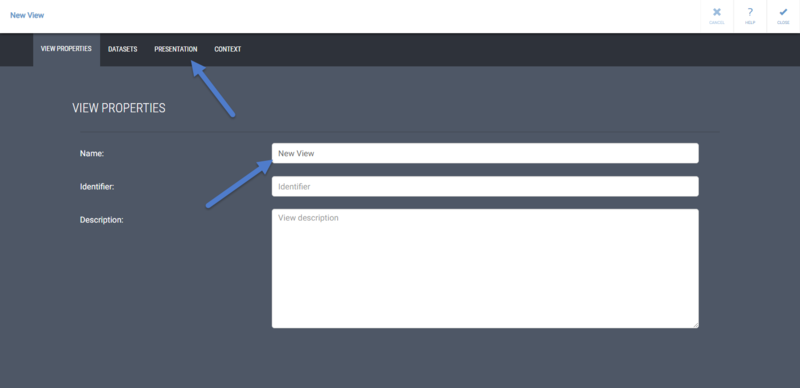
- The context defines the starting points for later querying data from QPR EnterpriseArchitect/ProcessDesigner, QPR Metrics, and/or QPR ProcessAnalyzer. Define the context by selecting values for the context variables by first selecting a variable from the drop-down menu and then tapping the edit icon on the Value column:
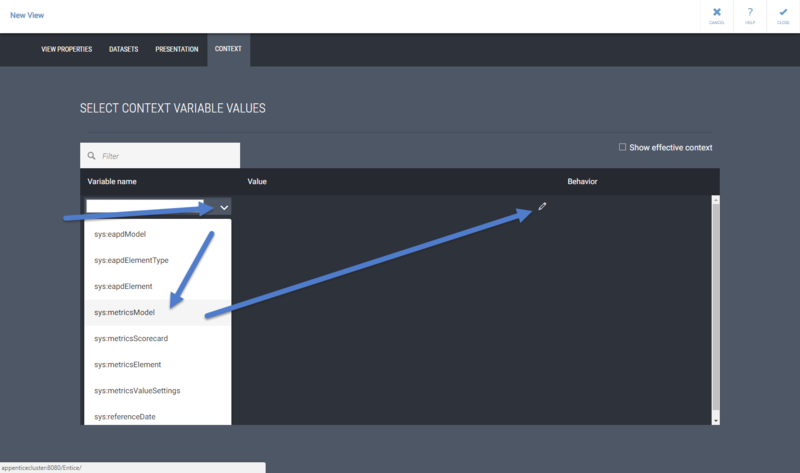
- To define your own context variables and their values, type in the name of the variable to the text field and click the check mark. After that, you can click the value field and type in the value for your custom context variable. See list of all system context variables.
- The Behavior selection affects the context variable used in the view in the following way:
- Default: the value of the context variable will be inherited from the higher level, i.e. Session (defined via the Selections button) → View → Panel → Presentation object. If there is no value for the context variable on a higher level, the value defined here will be used.
- Fixed: the value of the context variable will overwrite any existing effective value of the same context variable.
The panel and presentation object properties also have the Context tab. If you want a panel or a presentation object to always have a specific context variable value regardless of what is selected for the session, view, or panel, define the context variable in the panel or presentation object properties, and set the Behavior of the context variable to "Fixed".
To see what context variable values are used in the view, panel, or presentation object, select the Show effective context check box in the Context tab of the view, panel, or presentation object properties pages.
- The Behavior selection affects the context variable used in the view in the following way:
Using QPR EnterpriseArchitect/Processdesigner Data
- To use EnterpriseArchitect/ProcessDesigner data, define the sys:eapdModel, sys:eapdElementType, and sys:eapdElement context variables to set the default context instance. With the sys:eapdElement context variable, you can use the check boxes on the left side of the list to select the elements to which the view you are designing applies. These elements will then be selectable as the context instance via the Selections button when browsing the view. Selecting the All elements automatically check box will result in all elements of the element type defined by the sys:eapdElementType variable to be automatically available in the view when new elements of that type are added to the model.
Using QPR Metrics Data
- If you want to show data from element(s) that reside in some particular scorecard(s), define the sys:metricsModel and sys:metricsScorecard context variables. This is the most commonly preffered way of showing Metrics data.
- If you want to show data from a single Metrics element or measure, define the sys:metricsModel, sys:metricsValueSettings, and sys:metricsElement context variables.
The difference between these two approaches is that views with the sys:metricsScorecard variable defined can show data from multiple measures residing in the selected scorecards, whereas views with the sys:metricsElement variable defined are restricted to the measures selected here, but they enable browsing different measures using the same value settings as the selected measure.- With the sys:metricsScorecard and sys:metricsElement variables, you can use the check boxes on the left side of the list to select the scorecards/elements to which the view you are designing applies. These scorecards/elements will then be selectable as the context instance via the Selections button when browsing the view. Selecting the All scorecards/elements automatically check box will result in all scorecards/elements of the model defined by the sys:metricsModel variable to be automatically available in the view when new scorecards/elements of the defined sys:metricsValueSettings type are added to the model.
Using QPR ProcessAnalyzer Data
- If you want to show ProcessAnalyzer data, define the desired custom context variables and their values into the text fields. Some suggested variables to use: FilterId, ModelId, AnalysisType, MaximumCount, SelectedActivities, and SelectedTransitions. See the Analysis Parameters page for a more complete listing of possible variables.
After defining the view properties and context, click the Close button to apply the changes and exit the view properties.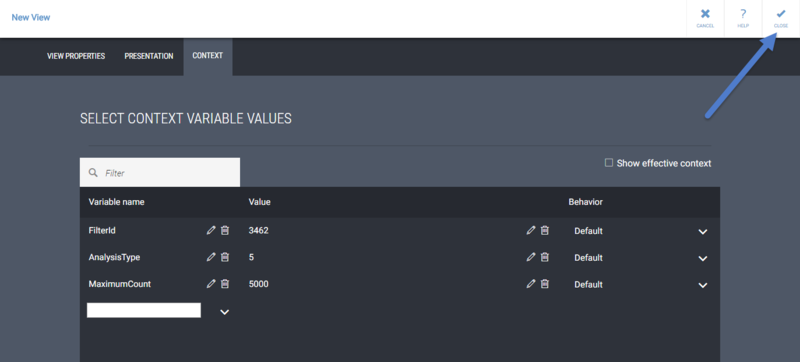
Select Period
By default, the QPR MobileDashboard view shows data from the Current period. As the view you are designing might not have data available for the current period, click the Selections button:
Then, select a period for which you have data:
